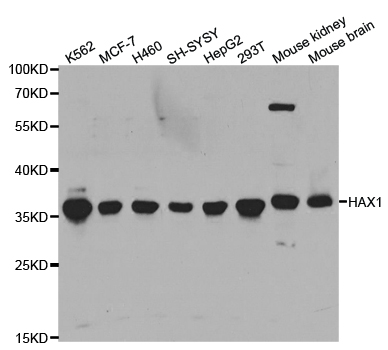HAX1 antibody
GTX101992
ApplicationsImmunoFluorescence, Western Blot, ImmunoCytoChemistry, ImmunoHistoChemistry, ImmunoHistoChemistry Paraffin
Product group Antibodies
TargetHAX1
Overview
- SupplierGeneTex
- Product NameHAX1 antibody
- Delivery Days Customer9
- Application Supplier NoteWB: 1:500-1:3000. ICC/IF: 1:100-1:1000. IHC-P: 1:100-1:1000. *Optimal dilutions/concentrations should be determined by the researcher.Not tested in other applications.
- ApplicationsImmunoFluorescence, Western Blot, ImmunoCytoChemistry, ImmunoHistoChemistry, ImmunoHistoChemistry Paraffin
- CertificationResearch Use Only
- ClonalityPolyclonal
- Concentration1.43 mg/ml
- ConjugateUnconjugated
- Gene ID10456
- Target nameHAX1
- Target descriptionHCLS1 associated protein X-1
- Target synonymsHCLSBP1, HS1BP1, SCN3, HCLS1-associated protein X-1, HAX-1, HCLS1 (and PKD2) associated protein, HS1 binding protein, HS1-associating protein X-1, HS1-binding protein 1, HSP1BP-1
- HostRabbit
- IsotypeIgG
- Protein IDO00165
- Protein NameHCLS1-associated protein X-1
- Scientific DescriptionThe protein encoded by this gene is known to associate with hematopoietic cell-specific Lyn substrate 1, a substrate of Src family tyrosine kinases. It also interacts with the product of the polycystic kidney disease 2 gene, mutations in which are associated with autosomal-dominant polycystic kidney disease, and with the F-actin-binding protein, cortactin. It was earlier thought that this gene product is mainly localized in the mitochondria, however, recent studies indicate it to be localized in the cell body. Mutations in this gene result in autosomal recessive severe congenital neutropenia, also known as Kostmann disease. Two transcript variants encoding different isoforms have been found for this gene. [provided by RefSeq]
- Storage Instruction-20°C or -80°C,2°C to 8°C
- UNSPSC12352203
References
- Berger CN, Crepin VF, Roumeliotis TI, et al. The Citrobacter rodentium type III secretion system effector EspO affects mucosal damage repair and antimicrobial responses. PLoS Pathog. 2018,14(10):e1007406. doi: 10.1371/journal.ppat.1007406Read this paper
- Hai J, Zhu CQ, Wang T, et al. TRIM14 is a Putative Tumor Suppressor and Regulator of Innate Immune Response in Non-Small Cell Lung Cancer. Sci Rep. 2017,7:39692. doi: 10.1038/srep39692Read this paper





![WB analysis of human heart tissue lysate using GTX84982 Hax1a antibody [9G6C6]. Working concentration : (A) 1 and (B) 2 microg/ml](https://www.genetex.com/upload/website/prouct_img/normal/GTX84982/GTX84982_3297_WB_20180221_w_23061420_916.webp)
![WB analysis of human brain tissue lysate using GTX84983 Hax1a antibody [9G3D11]. Working concentration : (A) 1 and (B) 2 microg/ml](https://www.genetex.com/upload/website/prouct_img/normal/GTX84983/GTX84983_3298_WB_20180221_w_23061420_448.webp)
![WB analysis of human brain tissue lysate using GTX84984 Hax1a antibody [8F9G7]. Working concentration : (A) 1 and (B) 2 microg/ml](https://www.genetex.com/upload/website/prouct_img/normal/GTX84984/GTX84984_3299_WB_20180221_w_23061420_438.webp)